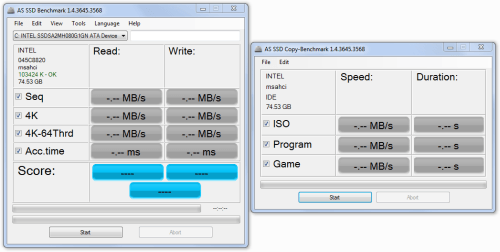- Qualcomm Launches Snapdragon 4 Gen 2 Mobile Platform
- AMD Launches Ryzen PRO 7000 Series Mobile & Desktop Platform
- Intel Launches Sleek Single-Slot Arc Pro A60 Workstation Graphics Card
- NVIDIA Announces Latest Ada Lovelace Additions: GeForce RTX 4060 Ti & RTX 4060
- Maxon Redshift With AMD Radeon GPU Rendering Support Now Available
Corsair Neutron GTX 240GB SSD Review

It’s the attack of the SandForce clones! Can any heroic atomic-powered SSD come to save us? Does Corsair’s Neutron have what it takes to rescue our PC in distress? Will the hordes of the positively-charged solid-state armies be neutralized in time? Tune in this week (or now) to find out!
Page 5 – Synthetic: AS SSD
As the name implies, AS SSD is a nifty little program written exclusively for solid-state drives. It can still be run on a mechanical hard drive just for fun, but be warned: what takes a few minutes on an SSD will require the better part of an hour on an HDD! It is freely available for download here.
This handy tool measures sequential reads and writes in addition to the important 4KB random reads and writes, then ranks the results with a final score for quick comparison with other SSDs. In addition to the main test there is a secondary benchmark that simulates the type of data transferred for ISO, Program, and Game files. We selected this program for its precision, ability to generate large file sizes on-the-fly, and because it is written to bypass Windows 7’s automatic caching system.





Second only to Iometer, AS SSD is one of the best tools for distinguishing between multiple SSDs while providing a scoring system for easier comparisons.
As before, the Neutron GTX trades places with the two other top-performing SSDs in both tests, while delivering strong performance in all four aspects of SSD performance: sequential reads & writes, and random reads & writes.
Although they end up having no discernible impact to the end user, it is worth noting that the Neutron is able to match the previously unmatched access latencies of the Vector, which is no small feat. In the copy tests, performance in all three scenarios gives it a solid second-place finish. Finally, in the final scores section, AS SSD awards the Neutron with our third score over 1,000 points. Although it receives a higher score for Reads, it is edged out by a slightly lower score in Writes which keeps the Neutron veritably tied with the Vertex 4. What’s also worth mentioning though is that the LAMD controller is able to offer this level of performance without any sort of data compression involved. This means consumers can expect more consistent high-performance regardless of how compressible the data in use actually is.
Support our efforts! With ad revenue at an all-time low for written websites, we're relying more than ever on reader support to help us continue putting so much effort into this type of content. You can support us by becoming a Patron, or by using our Amazon shopping affiliate links listed through our articles. Thanks for your support!





